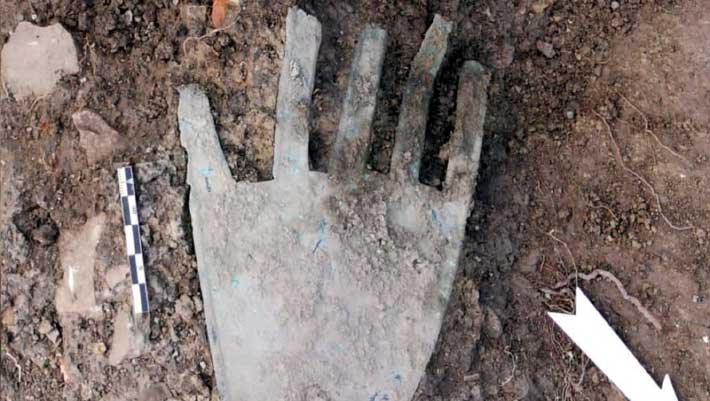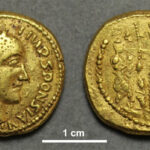Archaeologists in Spain have found a hand-shaped bronze object engraved with words in a Vasconic language, a precursor to the modern Basque language.
The flat bronze hand was found in June 2021 at the Iron Age site near the castle of Irulegi, located in the municipality of Aranguren in northern Spain.
Named the Hand of Irulegi, the artifact was designed to hang on a door, probably as an amulet of protection.
“It is a bronze plate in the shape of an outstretched right hand and a writing on the back,” said Dr. Mattin Aiestaran, director of the Irulegi excavation.
“Its patina contains 53.19% tin, 40.87% copper and 2.16% lead, something that is common in very old alloys, this one is about 2,000 years old.”
“The site dates from the 1st century BCE, a time before the arrival of the Romans, and is in the place where the classical sources located the territory of the Basques,” he added.
“The town was burnt down and later abandoned in a war episode, during the Sertorian Wars.”
The Hand of Irulegi contains 40 symbols distributed across four lines, probably corresponding to five or more words.
The first word, ‘sorioneku,’ closely resembles the word ‘zorioneko’ in present-day Basque-language (means ‘good fortune’).
“We were able to understand the first word, which is ‘sorioneku,’ but we still cannot decipher the following ones,” said University of the Basque Country’s Professor Joaquín Gorrochategui.
“It is the first document undoubtedly written in the Basque language and also written in a signatory that is also Basque,” said University of Barcelona’s Professor Javier Velaza.

The Hand of Irulegi is the oldest written record of a precursor of the Basque language. Image credit: SC Aranzadi.
“The graphic system in which it is written is peculiar. It is derived from the Iberian system, but it has undergone some adaptation to mark some sound or phoneme that does not exist in the Iberian signary, but does exist on coins minted in the Basque territory,” he added.
“Therefore, from the Irulegi hand, we can begin to speak about the existence of a truly Basque graphic system in operation at that time.”
“The artifact provides really interesting information, because it is currently accepted that the Basques did not use writing to write their own language in antiquity, and that it was not until the arrival of the Romans and with them the Latin alphabet, that they start writing.”
“This artifact turns upside down what until now we thought about the Basques and writing,” Professor Gorrochategui said.
“We were almost convinced that the Basques were illiterate in ancient times and did not use writing, nothing more than to mint some coin.”





